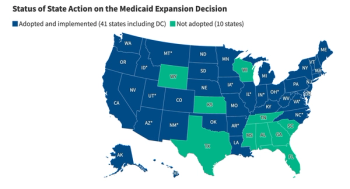
The “Risk” of Value-Based Care
Risk adjustment is a central feature of value-based care, but it can be abused. Natural language processing can make the process efficient and steer it clear of fraud and other problems.
The U.S. healthcare system produces billions of pages of medical records each year, and the data contained in these records is needed by multiple stakeholders for a multitude of purposes, such as adverse events reporting, disease trending, population health management, revenue cycle management (including federal incentives and payment integrity), and research. With chart reviews, all of these purposes are served individually. In other words, if eight different people need to analyze the information in a patient’s chart, the chart is reviewed eight times. It is within these frantic, mouse-clicked page-turns that the promise of value-based care is born — or extinguished.
Risk versus reward
Risk adjustment is a process used to appropriately compensate health plans and providers under value-based models. Health plans attempt to offset the higher costs associated with members that have chronic health conditions. The key to successful risk adjustment is to accurately identify patients’ full disease burden with substantiated data and documentation. Risk adjustment is necessary to ensure that health plans receive appropriate compensation for assuming responsibility for high-risk patients, and providers are compensated for accurately documenting and reporting patients’ conditions and treatment plans. The more elevated a patient’s disease risk, the greater the payment to health plans and providers, which makes accurate risk capture an important component.
Value-based care programs, such as Medicare Advantage, reward health plans for collaborating with providers to help patients access quality care and achieve better outcomes. However, the cost of care can vary widely depending on a patient’s overall health. The underlying risk adjustment scores provide health plans with a means of offsetting the higher cost of care for these patients based on the underlying conditions that increase their overall health risk. The capture of accepted risk factors requires a complete and accurate picture of a patient’s health, which can be challenging because critical details are often buried within unstructured text in the patient’s electronic health records (EHRs). For health plans, effectiveness in budgeting for value-based care arrangements heavily depends on accurately assessing risk at the patient and population levels.
Value is a risky business
Risk adjustment has also generated controversy. Last year, the U.S. Department of Justice filed a lawsuit against Buffalo-based Independent Health, a Medicare Advantage insurer, accusing it and a subsidiary of bilking the federal government out of millions of dollars over the course of nearly a decade by fraudulently adjusting risk scores to make members appear sicker than they were.
That may just be one incident of many. In 2020, the Medicare Payment Advisory Commission estimated that the risk scores for beneficiaries in Medicare Advantage were about 9.5% higher than what they would have been for a similar beneficiary in traditional Medicare, resulting in about
Related:
Risk adjustment has taken on greater importance in recent years as enrollment in value-based care plans such as Medicare Advantage has surged. In 2021, 26 million Americans were enrolled in Medicare Advantage plans, double the number in 2012, according to the
Increasing capture and reducing risk through technology
To accurately capture risk and associated compensation, health plans have traditionally relied on laborious manual chart reviews performed by highly trained and expensive coding and clinical staff. More recently, however, organizations are embracing artificial-intelligence-based tools, such as natural language processing, to quickly surface relevant patient information and identify key elements that support accurate risk assessment across patient populations. This is hardly an efficient, scalable model, and it predictably leads to inefficiencies, excessive administrative burden and, sometimes, even fraud. A better approach is to leverage natural language processing to effectively “touch” or analyze the information once, and then route specific details to each individual based on job function. Natural language processing frees healthcare professionals from having to hunt for small details within huge documents, and presents that data in a searchable, easy-to-digest format.
Many health plans have turned to AI-based technologies like natural language processing to scour patient records for critical details required to substantiate conditions. Natural language processing automates expensive, manual chart reviews, which sometimes require clinicians to wade through thousands of pages of documentation to pick out a tiny piece of data they seek. Notably, natural language processing is adept at analyzing unstructured text, which often contains important information into a patients’ current diagnoses which is often buried in the notes sections of EHRs. This data can then be standardized and mapped to HCC codes for accurate, data-supported risk capture.
In giving computers the ability to read, understand and interpret language, natural language processing does far more than merely identify the presence of words or elements within text. It leverages a semantic, contextual and longitudinal understanding of each patient so extractions can be leveraged to organize data from an individual’s health journey, an entire patient population, or an enterprise's data warehouse, an essential tool for performing risk adjustment at a large scale.
A path forward
While the industry’s progress towards value-based care has been relatively slow, these payment models are virtually certain to become more widespread in the coming years. To properly budget and set premiums for value-based arrangements, payers must accurately capture and quantify patient risk, at scale.
Incorporating artificial intelligence-based tools such as natural language processing into risk adjustment and document review workflows is the best risk-free path to accuracy and efficiency.
Newsletter
Get the latest industry news, event updates, and more from Managed healthcare Executive.





















































